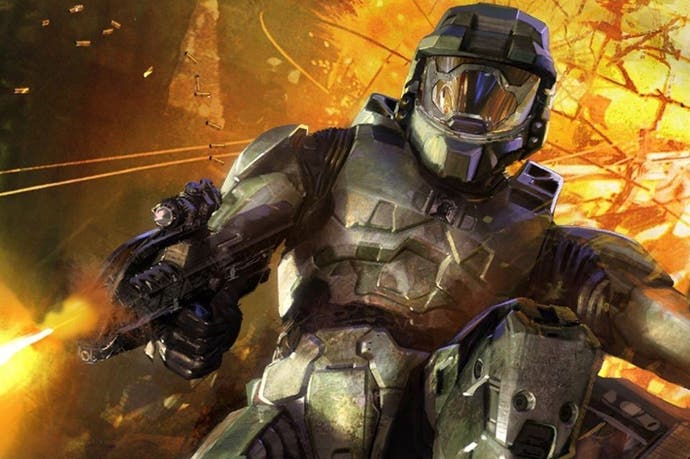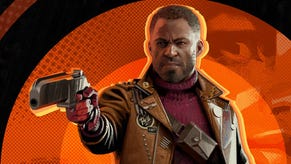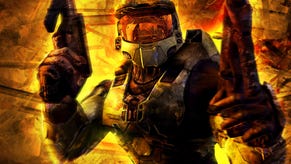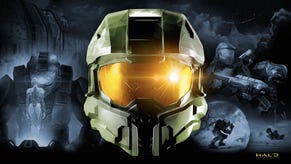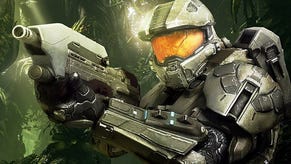Tech Analysis: Halo 2 Anniversary
Digital Foundry gets to grips with the Xbox 1 to Xbox One conversion.
Four major Halo remasters are included in The Master Chief Collection, but the Halo 2 Anniversary Edition is quite the package itself - a fitting tribute to a classic game celebrating its tenth anniversary this year. Saber Interactive returns from Halo Anniversary duties to handle the re-mastered campaign, while Certain Affinity, formed by ex-Bungie employee Max Hoberman, is tasked with remaking six of the game's multiplayer maps. On top of that, Blur Studio has recreated key cut-scenes as high-end CG renders, while 343 Industries facilitates the whole project. So what we have here is one game featuring three engines and four developers - five if you factor in Bungie's work on the original game. What could have been a disjointed mismatch of elements is anything but: the results are remarkable and the package is a significant leap over what was achieved with the original Halo's Anniversary release on Xbox 360.
Despite its cliffhanger ending, the Halo 2 campaign is still generally well regarded and we were excited to see how it is transformed for its Xbox One debut. Unlike the bulk of the Master Chief Collection, the campaign portion of Halo 2 Anniversary doesn't actually operate at a native 1080p which is no doubt the result of running two rendering engines simultaneously. The team has opted instead for a 1328x1080 framebuffer, which in terms of pixel count, actually contains fewer pixels than the default 900p choice. However, the end results generally look good, and appear visibly sharper as a result of scaling in just one direction. While still a fair bit blurrier than a full 1080p presentation, the end results are pretty acceptable considering the fluidity of the frame-rate. Both the classic campaign and multiplayer modes operate at full HD resolution - although it has to be said that Bungie's original visuals could sure use some anti-aliasing.
While we would have preferred the option to disable classic mode completely in order to sustain full HD visuals through the game, it has to be said that the switching technology is much improved from the original Halo 1 remaster on Xbox 360. This time, it's a lot faster. Saber has taken advantage of the extra memory and processing power to allow an instantaneous switch with no fading, pausing, or skipping. You can jam the button rapidly and marvel as the game flicks seamlessly back and forth. It really helps drive home the massive improvements the team has made and makes the option more interesting and usable.
Saber's initial work in remastering the original Halo was an interesting effort but there was always a sense that the artwork didn't faithfully recapture the look and feel of the original game. Halo 2 Anniversary sees great strides made to overcome this with a presentation that feels refreshed, yet true to the original designs. Colour schemes, texture patterns, and the raw artistic style all feel more in line Bungie's original work while the new layer of detail brings it up to speed with a more modern visual design. A completely new set of assets is created for this project with significantly more geometric and texture detail present throughout every scene.
It's amazing to see the new level of detail present throughout each scene - surfaces that were once completely flat have been replaced with intricate pipework and chunks of machinery, giving a new life to the level design. Foliage is plentiful where appropriate, with the transformation of Delta Halo in particular taking flat textures and replacing them with complex layers of foliage and trees. Normal maps were used extensively in the original Halo 2 to give the impression of greater detail, and the remaster adapts this effect into real geometry, while also utilising superior textures. Overall texture quality is excellent throughout with a nice boost in fidelity that goes well beyond what was achieved in the original Halo's Anniversary release on Xbox 360. All of these changes are cosmetic so you won't find yourself getting stuck on new pieces of scene geometry here. However, by directly tying the game to its original form the door is closed on improved animation or level tweaks - which seems like a bit of a missed opportunity in some ways.
It does allow for clear upgrades in other areas though. Fully dynamic shadows have been implemented throughout the campaign, giving extra depth to each scene, bringing the game more in line with Bungie's original vision for Halo 2. The team spent more than a year creating and ultimately scrapping a renderer that used stencil shadows to allow objects to cast and receive shadows. While it proved too demanding for the original Xbox hardware, those dreams have been fully realised in Halo 2 Anniversary, albeit with a different rendering approach. Shadow resolution isn't remarkably high but the quality of the filtering leaves them appropriately soft and free of any noticeable LOD 'pop-in' issues. Scene depth is further expanded with a solid ambient occlusion implementation that provides appropriate contact shadows where applicable. Anisotropic filtering is also utilised in both renderers, retaining crisp texture detail even at a distance. Impressively, it seems that AF was also selectively employed in Halo 2 on the original Xbox, but the implementation here is far more complete.
Particle effects also see a huge boost in quality, with nicely animated and well-lit explosions coupled with smoke plumes giving a real sense of body to the carnage. In addition, particles and smoke now properly receive lighting and shadow from surrounding objects. Unfortunately, the resolution of these effects is compromised in order to maintain a high frame-rate - looking closely at any explosion effect reveals some pretty serious pixellation. It's not usually a problem, but when the screen is filled with explosions and plasma it becomes pretty clear that resolution has been sacrificed.
Additionally, a beautiful implementation of high-dynamic range lighting has made its way into the game, producing results not unlike Bungie's own work on Halo 3. Transitions between cramped interiors to expansive exterior environments use this to create some remarkably dramatic lighting that is completely absent in the original game. Dynamic lights also play a larger role with every plasma shot producing its own light source, playing nicely off the texture work. This makes for some particularly dramatic moments while battling the Covenant, particularly within the game's darker environments. On the more subtle side, there's a nice glass shader utilised to give large panes of the material an appropriate appearance, while water has also been improved, though perhaps not to the same degree as the fully dynamic pools seen in Halo 3. Walking through these pools produces simple particle effects to simulate splashes rather than deforming the water mesh.
The classic mode, looks mostly as you would expect - sharp and angular. At 1080p60 many of the game's original assets just don't really hold up that well. The game's visuals were designed to be played at 480p on older CRT televisions, where it still looks quite nice, but under close examination on modern full HD displays it looks rather ugly - more so than the original Halo: Combat Evolved, in fact. The reliance on normal maps to simulate detail completely falls apart at a high resolution when their low resolution becomes obvious. So while it's nice to be able to look at the original visuals, this collection doesn't really allow users to see them as they were originally intended.
Then there's the matter of the newly remastered cinematics: select cut-scenes have been replaced with new high quality CG movies created by Blur Studio that look absolutely stunning. As impressive as they look however, they do create a rift between the in-game visuals and cut-scenes - the jump between the two very different visual styles can be rather jarring. Interestingly, you can toggle the original real-time Halo 2 cut-scenes at any point but they definitely don't hold up under the 1080p microscope. Animation is jerky and awkward, while character models are simply of too low a quality to work well at full HD resolution. It would have been neat to see the new graphics engine take on these sequences in real-time, but we still appreciate the effort put into the high quality renders. At least texture pop-in has been completely eliminated on the classic cut-scenes, allowing these sequences to be viewed as Bungie originally intended.
What they did not intend, however, is the addition of loading screens where once there were none. One of the feats of the original Halo 2 was the seamless nature in the way the game weaved between missions - once the game was loaded, the player wouldn't see another loading screen throughout the run of play. On Xbox One, however, loading screens pop-up following the end of each mission segment and sequences that once felt seamless are now broken up into chunks. This situation arises throughout the campaign but proves most jarring during the introduction sequence, where we see three cuts to loading screens before the game proper begins - somewhat disappointing when the original experience was completely seamless by comparison. Furthermore, replacing the stylised animated loading screens with static images was another bad move that detracts a touch from the quality of the overall presentation. This was always an element that separated Halo from other games and it's disappointing that something more in line with this design wasn't created here. It's an issue that persists throughout the entirety of The Master Chief Collection.
More positively, the developers deserve kudos for the revised audio mix - the entire soundscape has been remastered, with the intention of capturing the feel of the original audio, while taking advantage of improved hardware and techniques. The sound design makes better use of surround channels, providing a more immersive audio experience while additional channels and higher quality effects are used to create a more effective soundscape. The soundtrack too has been remixed in a higher quality, though the changes aren't always to our liking when compared to the original score. Toggling between the original soundtrack and the remastered audio along with the visuals is a nice touch though.
The multiplayer component of Halo 2 Anniversary is a completely different beast from the single-player campaign. Based on an updated Halo 4 renderer, the new Anniversary maps all operate at a full 1080p with some impressive design work throughout. Unfortunately, while the bump to a full 1080p is nice, some of the other improvements haven't made there way into this portion of the game. Most noticeably anisotropic filtering is completely absent, leaving otherwise excellent texture working looking a bit blurry at oblique angles. This is particularly frustrating as the new texture work is excellent and image quality is otherwise great.
The new Anniversary maps were created by a completely different team than the campaign and this manifests itself in the form of asset variation between the two modes, leading to some curious disparities. They're close enough that it may not initially register that there's a real difference, but if you look closely, you'll discover a completely different set of assets. Weapons and vehicles all look and sound different, explosion and particle effects have nothing in common between the two modes and at a higher resolution in multiplayer, the lighting effects are handled more like Halo 4 - on top of that, even the HUD is completely revamped. It's actually rather fascinating to see two completely different interpretations of Halo 2, especially when you consider the fact that this package also includes a third set of unique assets - the originals from Bungie. Since the multiplayer maps are not tied to legacy animation and design they do look and feel a bit more modern even if the campaign improvements are more drastic on paper.
One of the key features of The Master Chief Collection is its promised frame-rate - a full 60 frames per second across all four games. Replaying each of these games at 60fps has been a treat and thankfully, Halo 2 Anniversary manages to mostly deliver on this promise across all three engines. Not surprisingly, the campaign and multiplayer modes both handle slowdown completely differently though. Single-player has the odd torn frame manifesting at the very top of the screen, along with some dropped frames, but it's clear that lowering the resolution was the right move in the campaign as the end results are quite smooth. The same is true of the classic campaign, which manages to hold 60fps for the vast majority of the time. Surprisingly there are a few instances in which slowdown rears its head even in classic mode, leading us to once again conclude that utilising two renderers simultaneously is putting quite a strain on the system.
However, the updated multiplayer does not suffer from any screen-tear and instead uses a pure v-sync setup, in common with the Halo 4 conversion where the core tech hails from. Matchmaking wasn't enabled at the time of testing so we were limited to a smaller multiplayer match comprised of five players across all six of the new maps. Throughout the run of play the game does an exceptional job of maintaining a rock solid 60fps most of the time. Five of the maps pass muster with barely a blip but, unfortunately Zanzibar/Stonetown isn't quite as solid as we would like. With just five players on the map we encountered dips into the 50s (and sometimes lower) any time we were facing the central area with the large turbine. The drop in performance wasn't severe, but similar to Halo 4 on Xbox One, the game feels quite jerky and unresponsive when it does occur. Ultimately, while it's always disappointing to run across any frame-rate dips in a game, especially in multiplayer, the results are still very solid overall and it's safe to say that most users won't notice these issues. We're curious to see how Stonetown holds up with more players and we should have some additional information on that next week.
Halo 2 Anniversary: the Digital Foundry verdict
As the crown jewel in The Master Chief Collection, Halo 2 Anniversary delivers an expertly remastered experience for the new generation. The updated campaign is beautifully realised and feels closer to the source material than Saber's original attempt at remastering Halo: Combat Evolved back in 2011. The inclusion of the original classic mode remains an interesting treat for those interested in seeing the original visuals again, but we can't help but wonder if the image quality for the remastered campaign hasn't suffered a bit as a result of its inclusion. The new CG sequences are also a treat for fans of the game and demonstrate just how much further the Halo aesthetic could be pushed in the future.
The updated multiplayer maps are also exciting and rekindled a lot of nostalgia while playing through them. The visual overhaul is impressive and interesting though it does make it difficult to return to some of the classic Halo 2 maps after experiencing the new visuals. Despite the variation in assets between the campaign and multiplayer, the game still feels very much like Halo 2, which is ultimately what's most important here: this is the Bungie classic updated for a new generation - and it works brilliantly.
With Halo 2 having received far and away the most development effort can the rest of the package stand up to its quality? We've already presented some initial findings, but it's safe to say that there's still a lot more to cover. We'll have more information on how the other Halo games in The Master Chief Collection stack up next week when the game finally launches.
